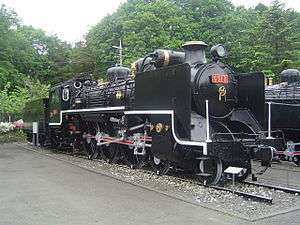JNR Class C51
Class C51|

|
| Type and origin |
|---|
|
Reference:[1] | | Power type |
Steam |
|---|
| Builder |
Kisha Seizō, Mitsubishi, JNR - Hamamatsu |
|---|
| Build date |
1919-1928 |
|---|
| Total produced |
289 |
|---|
|
|
|
| Performance figures |
|---|
| Maximum speed |
99.1 km/h (61.6 mph) |
|---|
|
The Class C51 (C51形) is a type of 4-6-2 steam locomotive built by Japanese National Railways (JNR). The C classification indicates three sets of driving wheels. The C51 introduced 1.75 m (5 ft 9 in) diameter driving wheels to Japan. C51s raised the average speed on the Tōkaidō Main Line from 47.3 km/h (29.4 mph) to 55.3 km/h (34.4 mph). In 1930, a C51 hauled the first Tsubame (swallow) express, reducing travel time between Tokyo and Kōbe to 9 hours.[1]
Preserved examples
As of 2012, four Class C51 locomotives were preserved at various locations.
See also
References
- 1 2 Naotaka Hirota Steam Locomotives of Japan (1972) Kodansha International Ltd. pp.57&96 ISBN 0-87011-185-X
- 1 2 3 4 Sasada, Masahiro (September 2012). 国鉄&JR保存車大全 [JNR & JR Preserved Rolling Stock Complete Guide]. Tokyo, Japan: Ikaros Publications Ltd. p. 132. ISBN 978-4863206175.
Japanese Railway Locomotives |
|---|
|
| Steam locomotives | | |
|---|
|
| Diesel locomotives | |
|---|
|
| Electric locomotives | |
|---|
